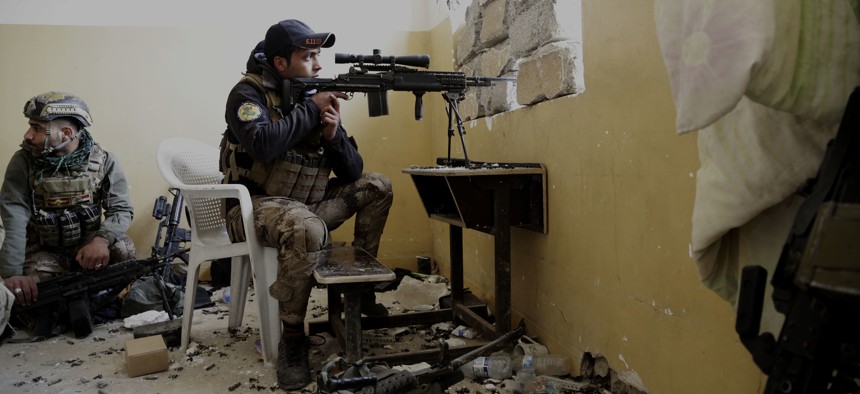
An Iraqi special forces sergeant watches the front line with Islamic State group fighters inside the Mamun neighborhood of western Mosul, Iraq, Thursday March 2, 2017. Susannah George/AP
Although there is much hard fighting to be done in Iraq, the fall of Mosul will effectively spell the end of the Islamic State’s eastern province. The Islamic State of Iraq and Syria will then be the Islamic State of Syria. In Arabic, we’ll have to start calling Daesh—the acronym for the Islamic State in Iraq and Syria—“Dish.”
Last fall, I visited Iraq on two occasions with the then-secretary of defense. On our last visit, in December, the U.S. commander on the ground, Steve Townsend, told the secretary that he could sense the Islamic State’s defenses in eastern Mosul were about to collapse. He was right. Since our visit, Iraqi troops have seized the entirety of eastern Mosul.
The campaign for Mosul in entering a new phrase, with Iraqi troops now pushing into the western half of the city. Mosul—and northern Iraq in general—is complicated human and physical terrain. Demographically, Mosul is a diverse city, ethnically and religiously, but its western half has always been more Sunni Arab than its eastern half. To the degree the Islamic State still has local support in Mosul, it is almost certainly greater in the western half of the city.
Physically, western Mosul is dense urban terrain emptying out into the western deserts of northern Iraq. If the Islamic State can be driven from the city, its fighters will present ripe targets for U.S. and allied air power.
Getting them out of the city, though, will be difficult, and thus far, Islamic State fighters have chosen to stay and fight rather than flee. Iraqi forces will have to fight block by block and street by street against an enemy that has had ample time to prepare its defenses and has learned from previous battles in Manbij in Syria, Sirte in Libya, and Fallujah in Iraq. The fight for western Mosul will take time and will further stress Iraqi forces exhausted from a hard fight for eastern Mosul.
Yet the Islamic State is essentially surrounded in Mosul—a condition that's presaged its defeat in other cities as well. Why haven't they fled before now? It’s anyone’s guess, but it’s worth remembering how we—the U.S. military and its partners—often assume the enemy understands his situation better than he actually does. Because we usually have good situational awareness, we assume the other guy does as well. But if we try to put ourselves in the shoes of the enemy amidst the fog of war, it’s very possible the Islamic State fighters simply failed to realize how cornered they were until it was almost too late.
Read more What ISIS Will Do After Mosul Falls
See also Iraq Agreed to Share More Information with US to Avoid Travel Ban
And Air Force Buys Mysterious Israeli Weapon to Kill ISIS Drones
A phenomenon whereby fighters fled a city while leaving a rump force behind has more or less repeated in places like Manbij, Sirte, and Fallujah until now. What makes 2017 different from last year is there are very few places to which the Islamic State fighters can still retreat. Aside from a few remaining strongholds in Iraq—most of them along the middle Euphrates River Valley—and a few towns in Syria such as Raqqa and Deir Ezzor, Islamic State fighters have few options for places to go.
One option remains the desert caves west of Mosul, while another would be the remaining cities under Daesh control in central Syria along the Euphrates River. The Russians and Assad regime, in particular, fear the Islamic State will retreat to the latter, where a small regime garrison hangs on by its fingernails outside Deir Ezzor.
Throughout the fall of 2016, Russian generals with whom I was negotiating in Switzerland on the fate of Aleppo would anxiously inquire about our plans for Mosul and Raqqa. They had not been successful in convincing either Iran or Hezbollah to devote larger numbers of fighters to the defense of the besieged regime garrison. Indeed, they had not been successful in convincing any of their coalition partners—Iran, Hezbollah, the Assad regime—to focus on fighting the Islamic State, which is just one of many reasons why partnering with Russia in Syria remains folly. At the same time in which U.S.-allied forces were dealing the Islamic State defeat after defeat, Russian-backed forces repeatedly failed, with much embarrassment, to even defend the isolated desert town of Palmyra in central Syria just a few hours drive from Damascus.
Ideally, of course, the Iraqis would be pressing the Islamic State in Mosul at the same time in which Russian-backed forces were doing the same in Deir Ezzor, and U.S.-backed Kurdish forces were doing the same in Raqqa. Simultaneous pressure against the Islamic State—pressure that creates dilemmas for where the Islamic State’s commanders devote their precious resources—won the gains of 2016.
The Trump administration, though, has decided to first conduct a review of the war effort in general before making a decision to arm the Kurds in Syria in a way that would surely anger Turkey. To be entirely fair, this is responsible governing: The Obama administration conducted its own review of the war in Afghanistan in 2009 prior to making any big decisions on troop commitments.
What decisions the Trump administration makes in Syria or elsewhere with respect to the Islamic State will be interesting and fraught with consequence. In Iraq, however, the Islamic State’s days are truly numbered. Although Islamic State terror attacks will continue, and although Islamic State redoubts remain spread out throughout the country, Mosul is the decisive battle, and when the Iraqi flag flies once again over all of Mosul’s neighborhoods, the Iraqis will have won a mighty victory.
NEXT STORY: Pick Up the Pace on Missile Defense



